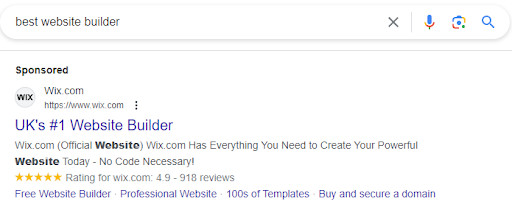Ad copy is the text used for various paid marketing campaigns to get users to take an action to guide them into the sales funnel. There are two main types of ad copy: short-form and long-form.
Short-form copy is used in pay-per-click advertising like search, display and social media advertising. As the name suggests, it’s short and to the point, making it difficult to create because you’re limited to a small character count.
Alternatively, long-form content is more lengthy and can be used to detail the benefits and features of a product or service. You’d typically find this type of content on a dedicated landing page.
With your target audience in mind, you should always craft copy that your audience expects to see – this is the case for all marketing channels.
By creating copy that resonates with their demographics, interests and behaviour patterns, your messaging can better reach who you want to see your content. For example, young homeowners are more likely to be interested in DIY flooring projects as they’re more likely to want to decorate their home themselves. Tone of voice is also important to get right and should always follow your brand-guidelines.
Much like the previous point, it’s important that you create copy that addresses your audience’s pain points. For example, a cat owner isn’t going to be interested in ads for dog food, even if the copy is engaging.
Identify the challenges your audience face, providing solutions and empathy in your ads to show that you understand their struggles. By tailoring your ad copy to alleviate these pain points, as well as setting up audience targeting to ensure you’re reaching the ideal audience for your products or services, will help increase conversion as you’re providing a solution to their needs.
As with any online industry, it can be difficult to ensure that the ads that you’re paying for appear above your competitors. To appear above your competitors, it’s important to understand what your competitors are writing about when you search for the products or services that you’re advertising.
At Proof3, our marketing teams will analyse your competitors ads to find gaps in their content. We will then ensure that the ad copy that we suggest addresses these gaps, adds additional value that competitors may be missing and resonates with your target audience.
CTAs are one of the most important elements of ad copy, specifically for headings. Depending on the platform (Google Ads, Facebook Ads etc), heading and descriptions are limited with how many characters can be used.
Use persuasive language that elicits a sense of urgency, such as ‘Buy Online Today’ or ‘Shop Now’. By strategically using effective CTAs throughout your ad copy, you can increase the chances of your audience converting and engaging with your ad.
As previously mentioned, each paid advertising platform has its own unique requirements when it comes to ad copy. To ensure that your ads are as effective as possible, it’s important to tailor your ad copy and audience targeting to align with the requirements of each platform and ad type.
For many Google Ads campaigns, you should focus on relevant keywords and concise messaging.
Display Ads and social media ads are more visual, so they require eye-catching imagery and minimal and direct ad copy to capture users’ attention.
A/B testing ad copy is an effective way to analyse the effectiveness of your ad copy, and there are many ways to A/B test each paid advertising platform.
Google Ads, allows you to manually test your ad copy or utilise Google Experiments. Manually A/B testing ad copy simply means setting up multiple versions of the same ad group, with different ad copy, to see which version is more effective at driving clicks and conversions.
Google Experiments is a much more straightforward testing process. To set up a new experiment, or to view existing experiments, click ‘Campaigns’ and ‘Experiments’. Click the ‘Ad Variation’ tab and create a new ad variation for the campaign that you want to test. If you choose the 50/50 default option, Google Experiments will show one variation of the ad copy to 50% of your audience and the other 50% will see the other version. Once the test has been running for some time, you’ll be able to see the impact of each variation to make data-driven changes to your ad copy based on the variation that converts the best.

Whilst there are many creative ways to use ad copy to engage with your audience, here are some of our favourite examples of companies that have mastered effective ad copy.
Wix did a great job of positioning themselves as an industry leader for ‘best website builder’. By using terms like ‘Everything You Need’ and ‘Powerful’, users are provided with an effective solution to their pain points to easily be able to create an effective website.
They also reiterate their ease of use by stating ‘No Code Necessary’ in the copy, targeting an audience who are in the market for a professional website builder, without the need for web design experience.

Quickbooks have mastered search intent to ensure that the user clicks on their ad. By understanding that users are comparing similar alternatives, Quickbooks have included the benefits of their website vs their competitors.
Using ad copy like ‘90% Off For 6 Months’ and explaining in brief what they offer, users are able to clearly see why they should choose Quickbooks compared to their competitors.

Regularly monitoring and testing different versions of your ad copy ensures that you appear above your competition. However, it can be time-consuming to stay above your competition.
At Proof3, our paid marking specialists are on hand to regularly monitor and update your copy where necessary to ensure that your ads are as relevant and effective as possible. Get in touch with our team today to find out more about how we can help.
Regardless of the industry, connecting with your target audience on an emotional level can be a powerful way to grab their attention and drive engagement. Whether you’re telling a story or adding humour, nostalgia or empathy in your ad copy, emotional appeals can help create a strong connection with your audience.
It’s important to be aware of common mistakes when creating ad copy. Common mistakes could be using a generic or vague headline, lack of urgency and failure to connect with your target audience’s needs and desires.
Not including CTAs is another common issue that ad copywriters make. People follow instructions, so not including a CTA can significantly impact how many people click on your ad.
Ad copy can be measured in a variety of ways. To measure the success of your ad copy, you can track metrics like click-through rate, conversions, clicks and ROAS. The strength of the ad copy can also be measured by analysing manual factors such as the clarity of the message, the relevance to your target audience’s needs and the overall impact on your audience.
